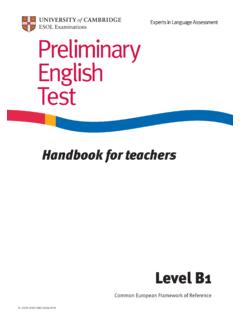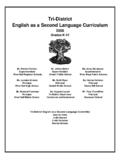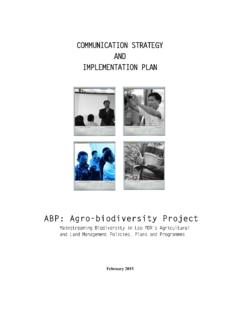Transcription of Country Note: Key findings from PISA 2015 for the …
1 Country NOTEKey fi ndings from PISA 2015 for the United States Country NoteKey findings from PisA 2015 for the United stAtesABOUT THE OECDthe oeCd is a unique forum where governments work together to address the economic, social and environmental challenges of globalisation. the oeCd is also at the forefront of efforts to understand and to help governments respond to new developments and concerns, such as corporate governance, the information economy and the challenges of an ageing population. the organisation provides a setting where governments can compare policy experiences, seek answers to common problems, identify good practice and work to co-ordinate domestic and international oeCd member countries are: Australia, Austria, Belgium, Canada, Chile, the Czech republic, denmark, estonia, finland, france, germany, greece, hungary, iceland, ireland, israel, italy, Japan, Latvia, Korea, Luxembourg, mexico, the netherlands, new Zealand, norway, Poland, Portugal, the slovak republic, slovenia, spain, sweden, switzerland, turkey, the United Kingdom and the United states.
2 The european Commission takes part in the work of the THIS REPORT this paper is published under the responsibility of the secretary-general of the oeCd. the opinions expressed and arguments employed herein do not necessarily reflect the official views of oeCd member document and any map included herein are without prejudice to the status of or sovereignty over any territory, to the delimitation of international frontiers and boundaries and to the name of any territory, city or work is available under the Creative Commons Attribution-nonCommercial-shareAlike igo (CC By-nC-sA igo). for specific information regarding the scope and terms of the licence as well as possible commercial use of this work or the use of PisA data please consult terms and Conditions on oeCd 2016the statistical data for israel are supplied by and under the responsibility of the relevant israeli authorities.
3 The use of such data by the oeCd is without prejudice to the status of the golan heights, east Jerusalem and israeli settlements in the West Bank under the terms of international note Key findings from PisA 2015 for the united stAtes OECD 20163the development of this report was led by yuri Belfali and miyako principal authors of the Chapters 1 and 2 were miyako ikeda, Carlos gonz lez-sancho and Jeffrey mo, and Bonaventura francesco Pacileo provided analytical support. Chapter 3 was co-ordinated by yuri Belfali and Ben Jensen, authored by Ben Jensen, Katie roberts-hull, maie Kitsing, Viive ruus and dennis shirley.
4 Michael fullan, Linda Kaser, Judy halbert, scott Benwell and Vivien stewart provided 4 is a contribution from the new york Academy of sciences and stanford research institute international, and authored by Britte haugan Cheng, Cynthia d Angelo, gloria miller, ruchi Bhanot, Jennifer Van Brunt and hank nourse, with inputs from the oeCd secretariat. dana Kelly (PisA governing board member for the united states) provided comments on the draft Limoges, Cassandra davis and rose Bolognini co-ordinated the publication process, editorial support was provided by marilyn Achiron and susan Copeland, and administrative support was provided by Juliet evans and Claire production of this report was funded by the hewlett foundation.
5 Table of contents Table of conTenTs5 Country note Key findings from PisA 2015 for the united stAtes OECD 2016 Acknowledgements .. 3eXecutive summAry .. 7 ChapTEr 1 whAt is PisA? .. 9what is unique about PisA? .. 10which countries and economies participate in PisA? .. 11what does the test measure? .. 12how is the assessment conducted? .. 13who are the PisA students? .. 14what kinds of results does PisA provide? .. 15where can you find the results? .. 15 ChapTEr 2 viewing educAtion PerformAnce And equity in the united stAtes through the Prism of PisA 2015 .. 17science learning outcomes .. 18science-related attitudes and beliefs.
6 22equity in the distribution of student opportunities and outcomes .. 26factors associated with equity .. 37 ChapTEr 3 Policies And PrActices for equity in educAtion in the united stAtes .. 41introduction .. 42what the united states can learn from other education systems .. 42 Policy 1: education strategy to improve performance and equity .. 46 Policy 2: rigorous and consistent standards across all classrooms .. 47 Policy 3: improved teacher and leader capacity across the system .. 50 Policy 4: equitable access to resources .. 52 Policy 5: targeting at-risk students and schools .. 54conclusion .. 56 ChapTEr 4 APProAches to science educAtion for 21st century leArning in the united stAtes.
7 61considerations for developing science instruction in the united states .. 63foundational principles of science learning .. 64science curriculum design .. 65 Pedagogical approaches to science instruction .. 66science instruction activities .. 68conclusion .. 70 Table of conTenTs6 OECD 2016 Country note Key findings from PisA 2015 for the united stAtesTablestable A comparison of the united states and four high-performing countries/economies in PisA 2015 .. 20bOXesBox PisA s contributions to the sustainable development goals .. 10 Box Key features of PisA 2015 .. 12 Box A context for comparing the united states to other PisA participants.
8 19 Box definition of socio-economic status in PisA .. 27 Box opportunity to learn .. 48 Box new pedagogies for deep learning .. 49 Box inquiry and formative assessment focus in Canada .. 49 Box disaggregating data to target disadvantage in British Columbia .. 54 Box estonia s emphasis on metacognitive skills may help disadvantaged 55 Box systematising the goals and features of science instruction materials .. 63 Box teaching strategies and students performance in PisA .. 67 Box more technology, better performance? .. 69 FIGUR esfigure map of PisA countries and economies .. 11figure united states mean scores in science, reading and mathematics across PisA assessments.
9 18figure mean science performance in the united states and selected PisA 2015 participants, at national and subnational levels .. 19figure students proficiency in science in the united states and selected PisA 2015 participants .. 22figure students science-related career expectations in the united states and selected PisA 2015 participants .. 24figure socio-economic status and science performance in the united states and selected PisA 2015 participants .. 28figure Change between 2006 and 2015 in the strength of the socio-economic gradient and average three-year trend in science performance.
10 29figure Change between 2006 and 2015 in the slope of the socio-economic gradient and average three-year trend in science performance .. 30figure Likelihood of low performance among disadvantaged students in the united states .. 31figure Percentage of resilient students in PisA 2015 and PisA 2006 in the united states and selected PisA 2015 participants .. 32figure mean performance in science, by international decile of socio-economic status, in the united states .. 33figure Performance differences between and within schools and socio-economic status in the united states .. 34figure student performance in science, by schools socio-economic profile in the united states.














